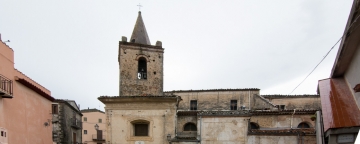Chiesa di S. Bartolo di Geraci Siculo
Chiesa di S. Bartolo di Geraci Siculo
The Church of St. Bartolo is located in the homonym square outside the village. Tradition says that this church was temporarily the Ventimiglia family sepulcher. But the real family Pantheon was realised in Castelbuono during XV century. Probably the church existed before 1338 because its architectural elements remind of medieval church style. Its orientation along an east-west axis, with a circular apse to the East and an entrance porch below the bell tower to the west, reminds the norman edification style. The church is composed by a compartment attached, on its western side, to a tower built on four pillars, two of whom made with stones mixed with lime and two with squared stones, maybe residues of romanesque triumph arch. This information can be inferred by an Arab style window located on the southern side and observation window now closed, visible from the tower northern side. During XV century the sepulcher was expanded in its front and raised together with the tower. The church has a single nave. The original building was lower than the present one, as it easily understandable by the presence in the superior part of an arch with two windows above a lower but more modern construction compared to the rest of the building, which served as pilgrims refuge. The church was expanded on 1775; embellished and decorated in 1794 with fine fillers in baroque composite style, by the artists Francesco, Clemente and Rocco Lo Cascio. (doc. 1794). Was later restored on 1978. The altar is composed by an old chestnut table. The floor was once made with local terracotta, but nowadays is made with marble.
ARTWORKS:
FOUNTAIN: It is located at the entrance. It came from the XIV century augustinian cloister. Its artistic sculture is also composed by a bas-relief representing St. Bartholomew.
POLYPTYCH: This artwork is made in Comiso white marble. Except for the Enthroned Madonna with Child statue, the St. James and St. Bartolo ones are in bas-relief. At the top is depicted the Eternal Father holding the world; below, in the center are located the Pietà with the three Mary. (Maria SS., Maria from Magdala and Maria from Cleofe). At the sides in two medallions is represented the Annunciation: on the left side the angel and on the right Mary. In the central part is located the Enthroned Madonna with Child with St. James on the right and St. Bartolo on the left. Under the saints statues are represented their martyrdom. In the central inferior part is located a Nativity scene with St. Paul on the right and St. Peter on the left. At their side are located Geraci Marquis and his wife. (probably Simone II Ventimiglia, son of Giovanni I and grandson of Simone I, with his wife Maria Ventimiglia). The polyptych is located in the front wall. Realised during XVI century, its author is probably Antonello Gagini and its apprentices (Vincenzo and Fazio).
BARTOLO CHAPEL: DOORS: They are made in wood. They close the niche left side. In their superior part are represented two angels with the symbol of Faith and Hope.
STATUE: Unknown author from XVI century. It is a representation of St. Bartolo holding in its right hand a knife, symbol of its martyrdom, and a book in the left hand. It a polychrome wooden sculpture.
PAINTING: Made on XVII century it represents two scenes: the upper one is the Madonna della Cintura and the lower one is S. Nicola from Tolentino in his deathbed supported by two angels.
PAINTING: It represents the Annunciation, made during XVII century. This painting was brought to Geraci with a procession in occasion of cholera epidemy on 1837.
STOUP: It is made in alabaster marble and dated 1552. On the edge can be read: "ANNO DOMINI INCARNATI VERBI: X INDICIONIS: N: SS. 2". It came from Augustinian cloister.
INSCRIPTION: It is located in the internal part of the entrance door and is made in plaster. "D. O. M. TEMPDUM HOC DIVO BARTHOLOMEO APOSTOLO AB AEVO DICATUM ORNATUM ET DEALBATUM EST S. T. D.: D. JACOPO GIALLUMBARDO ARCHPRESBITERO SAC.TE. D. JOSEPH VIVINETTO PROCURATORE AN. DOMINE 1794. RESTAURATUM 1978".









